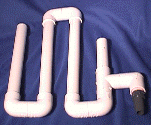CedzAquAddictio
New member
Yeah Man. The overflow is your culprit. I've dealt with over-the-top or HOB overflows before. Normally there is a small reservoir attached to the top of them to act as a baffle for small fluctuations which you don't have. You are running a direct full siphon and it seems like the pipes are the same size for your return and drain with more restrictions on the drain as it enters the sump. In essence, it seems that your drain relies on sucking the water out instead of the water draining into it. Kind of a sticky situation that will probably lead to a nasty flood from your DT or sump (probably the DT in this case). You are basically pumping in water faster than it is able to drain it.
Here's what we have to remember. Your return is being fed by a pump, and your drain is not. Therefore your drain must be able to handle what the return pump puts out and more. This often leads to larger drain piping.
Bottom line: With that setup, it may not ever become balanced. You will have to keep your underperforming drain matched EXACTLY to the return pump, and there can never be any changes in flow, pressure, etc (which occurs daily if not hourly as bacteria builds up).
If you can, drill into the back of your tank, and plumb the drain like they do in the fish stores. This will require larger plumbing, but will be safer and will give the air somewhere to go as well.
If drilling isn't an option and you want to stay DIY, Google durso overflow, and check out that design.
Best of luck and keep us posted...
Here's what we have to remember. Your return is being fed by a pump, and your drain is not. Therefore your drain must be able to handle what the return pump puts out and more. This often leads to larger drain piping.
Bottom line: With that setup, it may not ever become balanced. You will have to keep your underperforming drain matched EXACTLY to the return pump, and there can never be any changes in flow, pressure, etc (which occurs daily if not hourly as bacteria builds up).
If you can, drill into the back of your tank, and plumb the drain like they do in the fish stores. This will require larger plumbing, but will be safer and will give the air somewhere to go as well.
If drilling isn't an option and you want to stay DIY, Google durso overflow, and check out that design.
Best of luck and keep us posted...

